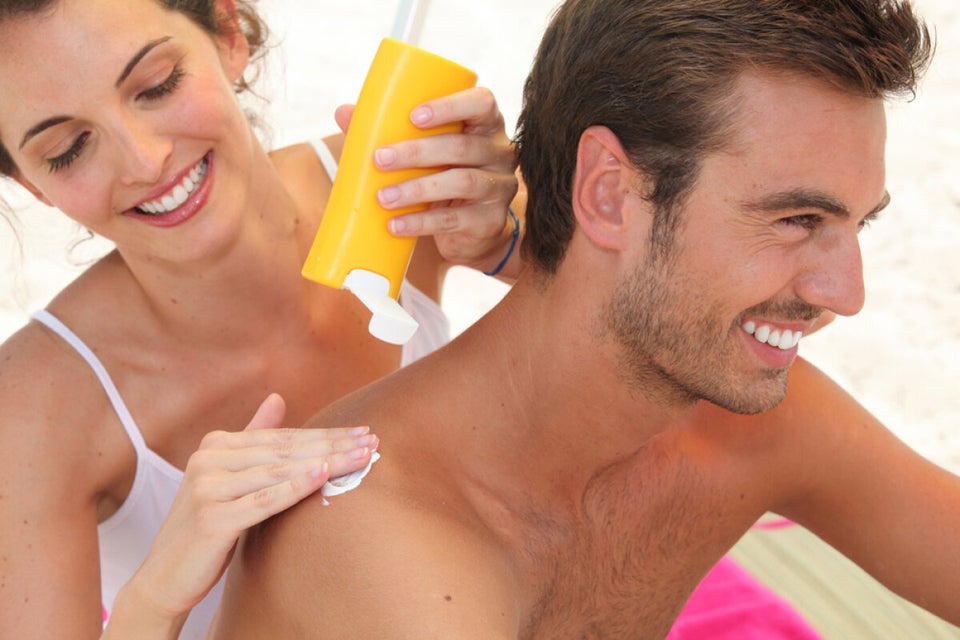
As a husband and father who enjoys family vacations at picture-perfect seaside destinations I can understand the argument behind "feeling elated" when the warmth of the sun beats down on you. As a Dermatologist I have to warn you -- there is no such thing as a "healthy glow" from a suntan.
In fact, ultraviolet radiation from the sun has been classified by the World Health Organization as "known to be carcinogenic to humans." Meaning, we have proven scientifically that sun exposure causes skin cancer.
Apart from being potentially life-threatening (i.e., skin cancer), the sun also fast-tracks the aging process. Imagine the sun as the opposite of the fountain of youth. Skin that has been exposed to the sun, whether because of sun worshipping or excessive exposure due to outdoor activities, ages prematurely. Premature aging means that the changes that occur in the skin are not due to the natural aging process and can be prevented.
Sunlight & Ultraviolet (UV) Radiation.
Where's the danger coming from? Light travels from the sun to the earth as an elelectromagnetic wave. UV radiation is found in sunlight. It passes through the ozone layer as waves of energy and cannot be felt nor seen by us. UV radiation can be classified into UVA and UVB.
Both UVA and UVB cause our skin to age more rapidly than if we were to avoid the sun and use proper protection (sunscreens, clothing, hats). Therefore, sun exposure is considered a form of "extrinsic aging." This means that our skin ages due to something in the environment. In fact, most premature aging can be accounted for by exposure to ultraviolet (UV) radiation from the sun. Smoking, another "known carcinogen" comes in second place. "Intrinsic" aging, on the other hand, is due to our genetics: essentially it represents the biological clock of our skin cells.
Assault on your Skin Cells!
Many people still measure "damage" from the sun in the form of a sunburn or "feeling too hot." What many have not learned is that UV radiation (remember -- this is neither felt nor seen) causes DNA damage to our skin cells and affects the protective functions of our skin.
UVA and UVB radiation actually changes the way our skin cells make chemicals. For example, tanned skin is the result of the overproduction of melanin -- the chemical that darkens the skin. This is the skin's natural response to protect against damage. Chronic or excessive sun exposure can cause skin cells producing melanin to mutate and divide uncontrollably, resulting in uneven or irregular pigmentation of the skin.
Photoaging -- Skin Aging Caused by the Sun
The medical term used to describe the damage the sun inflicts on our skin is "photoaging." If your skin is repeatedly exposed to sunlight without the necessary precautions, your skin loses its ability to repair itself. What is critical to understand, and should be explained to every parent by their pediatricians so that good habits develop early on, is that the damage accumulates over time -- from infancy to adulthood.
Scientific studies have shown that repeated UV exposure breaks down collagen and impairs the synthesis of new collagen. The sun also attacks our elastin fibers. Without the skin's supportive connective tissue (collagen and elastin) our skin loses its strength and flexibility. Essentially, the sun makes us look older, faster.
Our Skin Regretfully has the Best Memory!
"FRY NOW -- PAY LATER!!" These words of warning are from a skin cancer awareness advertising campaign (American Academy of Dermatology) and they are indisputable. Your skin is like a daily diary that's being kept from a very young age. It doesn't forget -- it keeps track. Every time we expose ourselves to the sun, changes to our skin occur. Over time these changes will alter how our skin looks and feels. These changes don't happen overnight!
Most people mistakenly consider the changes that their skin experiences over time as a normal part of aging. The fact is that the changes that we undergo as a result of photoaging are preventable and are not the natural aging process. If our skin has not been exposed to UV radiation it ages differently.
The skin changes, caused by photoaging, that are responsible for most of the harm that we view as aged skin and that are not inevitable include:
a) a leathery skin texture
b) loose & wrinkled skin
c) dryness
d) freckles
e) sun spots (often seen on the backs of the hands, chest, shoulders, arms, and upper back commonly referred to as 'liver spots' but are strictly related to sun damage)
f) easy bruising
g) skin growths
h) rough/reddish skin patches (actinic keratoses)
i) the appearance of red blood vessels
j) thinning of and yellow discoloration of the skin
Sun Exposure - It's not just Tanning by the Pool.
A great misconception is that most people think sun-damaged skin is a result of intentionally sun-tanning. What is consistently underestimated by us is the amount of incidental exposure people acquire from "outdoor" activities such as walking to the car, sitting on a park bench and even driving during the daytime (UVA radiation is not filtered by glass so windows do not protect you!).
The cumulative exposure from these brief moments is enough to cause the skin changes listed above. As a general rule -- the more chronic the exposure, the more severe the sun damage.
Another very common but mistaken belief is that the sun is only dangerous in the summer. Exposure to the sun during the fall, winter and spring months puts you at risk just as exposure during the summertime does. Just look at veteran skiers who have had a lifetime of sun reflecting off the snow!
Reversing Skin Aging Begins with Staying out of the Sun!
The visible signs of skin aging are, no doubt, a growing cosmetic concern as people are living longer and there is a general trend towards maintaining a healthier lifestyle. Unhealthy-looking skin does not reflect how people feel about themselves as they generally feel a lot younger than their chronological age. A woman in her early 50s who has had too much sun may look 10 years older than her actual age but she does not have to accept that "fate."
Aesthetically speaking, there are a multitude of medical treatments that do, to a certain extent, reverse the signs of skin aging. Understanding the harmful effects of the sun and modifying certain habits is key to preventing further damage and should be the first step towards rejuvenating your skin.
